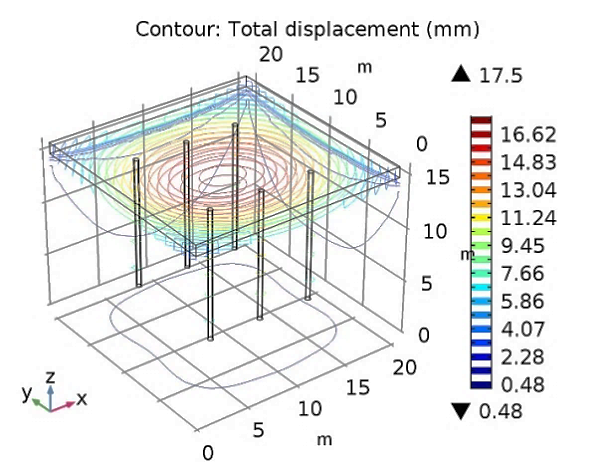Appraisal of Hybrid Foundations on Loose Granular Soil of Western Saudi Arabia
DOI:
https://doi.org/10.46604/peti.2020.5515Keywords:
loose sand, hybrid foundation, pile arrangement, foundation settlementAbstract
Western Saudi Arabia is the most important geographic location for the Islamic world. Millions of pilgrims annually visit the region. To accommodate this huge number of pilgrims, various tall buildings are constructed, yet there is a need for many more. The demolition of old buildings is also in progress. The soil supporting of the foundations mostly comprises sand with varying relative density. Most of the buildings are supported by conventional foundations, which require deep excavation for low relative densities. The combinations of pile and raft or hybrid foundations have been effectively used in tall buildings around the globe. In this research, COMSOL Multiphysics FEM analysis has been adopted to investigate the performance of a hybrid foundations with different pile combinations supported on loose granular soil. The results reflect the effective utilization of the hybrid foundation on loose sand. The arrangement of piles in the foundation system can affect the economy and safety of the structure.
References
M. Abuhjeeleh, “Rethinking tourism in Saudi Arabia: royal vision 2030 perspective,” African Journal of Hospitality, Tourism, and Leisure, vol. 8, no. 5, pp. 1-16, 2019.
A. A. Farag, “The story of NEOM City: opportunities and challenges,” New Cities and Community Extensions in Egypt and the Middle East, Springer Press, June 2018, pp. 35-49.
G. F. Brown, D. L. Schmidt, and A. C. Huffman Jr., “Geology of the arabian peninsula: shield area of western saudi arabia,” US Geological Survey, 1989.
J. B. BURLAND, M. C. Burbidge, E. J. Wilson, P. R. Vaughan, C. R. I. Clayton, P. R. Filho, et al., “Discussion. settlement of foundations on sand and gravel.,” Proc. of the Institution of Civil Engineers, December 1986, pp. 1625-1648.
J. He, J. Chu, and H. Liu, “Undrained shear strength of desaturated loose sand under monotonic shearing,” Soils and Foundations, vol. 54, no. 4, pp. 910-916, July 2014.
M. T. Naqash, Q. U. Farooq, and O. Harireche, “Seismic evaluation of steel moment resisting frames (MRFs)—supported by loose granular soil,” Open Journal of Earthquake Research, vol. 8, no. 2, pp. 37-51, May 2019.
J. Berrill and S. Yasuda, “Liquefaction and piled foundations: some issues,” Journal of Earthquake Engineering, vol. 6, pp. 1-41, 2002.
G. Madabhushi, J. Knappett, and S. Haigh, Design of pile foundations in liquefiable soils, World Scientific, 2009.
T. Thavaraj, W. L. Finn, and G. Wu, “Seismic response analysis of pile foundations,” Geotechnical and Geological Engineering, vol. 28, no. 3, pp. 275-286, March 2010.
W. L. Finn, “A study of piles during earthquakes: Issues of design and analysis,” Bulletin of Earthquake Engineering, vol. 3, no. 2, pp. 141, January 2005.
H. G. Poulos, “Piled raft foundations: design and applications,” Geotechnique, vol. 51, no. 2, pp. 95-113, March 2001.
H. G. Poulos, J. C. Small, and H. Chow, “Piled raft foundations for tall buildings,” Geotechnical Engineering Journal of the SEAGS & AGSSEA, vol. 42, no. 2, pp. 78-84, June 2011.
M. Majima and T. Nagao, 14. Behaviour of piled raft foundation for tall building in Japan, Thomas Telford, 2000.
B. Hor, M. J. Song, M. H. Jung, Y. H. Song, and Y. H. Park, “A 3D FEM analysis on the performance of disconnected piled raft foundation,” Japanese Geotechnical Society Special Publication, vol. 2, no. 34, pp. 1238-1243, 2016.
D. D. C. Nguyen, S. B. Jo, and D. S. Kim, “Design method of piled-raft foundations under vertical load considering interaction effects,” Computers and Geotechnics, vol. 47, pp. 16-27, August 2012.
M. Y. Fattah, M. A. Yousif, and S. M. Al-Tameemi, “Effect of pile group geometry on bearing capacity of piled raft foundations,” Structural Engineering and Mechanics, vol. 54, no. 5, pp. 829-853, 2015.
ASTM Committee D-18 on Soil and Rock, Standard practice for classification of soils for engineering purposes (unified soil classification system), ASTM International, 2006.
M. Color, Munsell soil color charts , 1975.
M. Cubrinovski and K. Ishihara, “Maximum and minimum void ratio characteristics of sands,” Soils and Foundations, vol. 42, no. 6, pp. 65-78, 2002.
“COMSOL,” https://www.comsol.com/documentation, 2014.
J. F. Labuz and A. Zang, “Mohr–Coulomb Failure Criterion,” Rock Mechanics and Rock Engineering, vol. 45, pp. 975-979, July 2012.
American Concrete Institute, Building code requirements for structural concrete (ACI 318-95) and commentary (ACI 318R-95), The Institute, 1995.

Published
How to Cite
Issue
Section
License
Submission of a manuscript implies: that the work described has not been published before that it is not under consideration for publication elsewhere; that if and when the manuscript is accepted for publication. Authors can retain copyright of their article with no restrictions. Also, author can post the final, peer-reviewed manuscript version (postprint) to any repository or website.

Since Oct. 01, 2015, PETI will publish new articles with Creative Commons Attribution Non-Commercial License, under The Creative Commons Attribution Non-Commercial 4.0 International (CC BY-NC 4.0) License.
The Creative Commons Attribution Non-Commercial (CC-BY-NC) License permits use, distribution and reproduction in any medium, provided the original work is properly cited and is not used for commercial purposes







